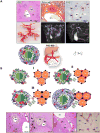Characterization of animal models for primary sclerosing cholangitis (PSC)
- PMID: 24560657
- PMCID: PMC4517670
- DOI: 10.1016/j.jhep.2014.02.006
Characterization of animal models for primary sclerosing cholangitis (PSC)
Abstract
Primary sclerosing cholangitis (PSC) is a chronic cholangiopathy characterized by biliary fibrosis, development of cholestasis and end stage liver disease, high risk of malignancy, and frequent need for liver transplantation. The poor understanding of its pathogenesis is also reflected in the lack of effective medical treatment. Well-characterized animal models are utterly needed to develop novel pathogenetic concepts and study new treatment strategies. Currently there is no consensus on how to evaluate and characterize potential PSC models, which makes direct comparison of experimental results and effective exchange of study material between research groups difficult. The International Primary Sclerosing Cholangitis Study Group (IPSCSG) has therefore summarized these key issues in a position paper proposing standard requirements for the study of animal models of PSC.
Keywords: Animal model; Bile acids; Biliary fibrosis; Cholangiopathies; Cholestatic liver disease; Primary sclerosing cholangitis.
Copyright © 2014 European Association for the Study of the Liver. Published by Elsevier B.V. All rights reserved.
Conflict of interest statement
Figures



References
-
- Wiesner RH, Grambsch PM, Dickson ER, Ludwig J, MacCarty RL, Hunter EB, et al. Primary sclerosing cholangitis: natural history, prognostic factors and survival analysis. Hepatology. 1989;10:430–436. - PubMed
-
- Fausa O, Schrumpf E, Elgjo K. Relationship of inflammatory bowel disease and primary sclerosing cholangitis. Semin Liver Dis. 1991;11:31–39. - PubMed
Publication types
MeSH terms
Grants and funding
LinkOut - more resources
Full Text Sources
Other Literature Sources

